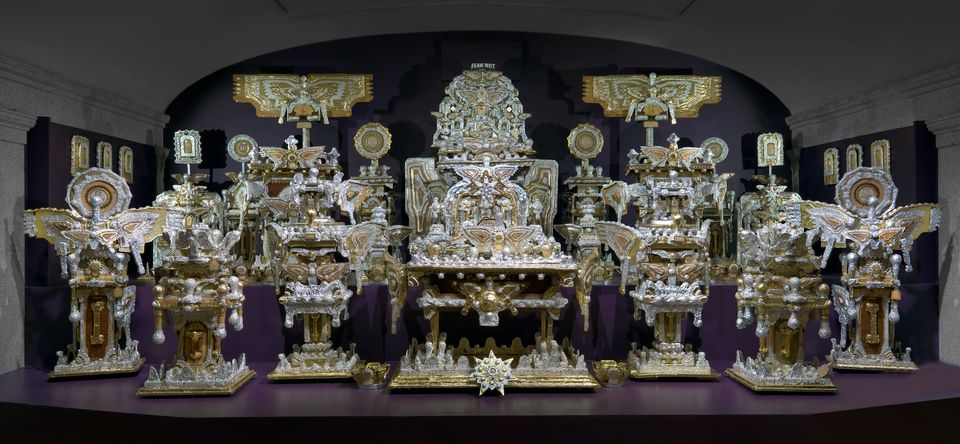Artwork Details
- Title
- The Throne of the Third Heaven of the Nations’ Millennium General Assembly
- Artist
- Date
- ca. 1950-1964
- Location
- Dimensions
- dimensions variable
- Credit Line
- Gift of anonymous donors
- Mediums
- Mediums Description
- mixed media
- Classifications
- Highlights
- Subjects
- Religion — Christianity
- Allegory — religion — salvation
- Object Number
- 1970.353.1-.134
Artwork Description
The Throne of the Third Heaven of the Nations' Millennium General Assembly is a complex work of art created by James Hampton over a period of fourteen years. Hampton made the array based on several religious visions that prompted him to prepare for Christ's return to earth. His reference to the "third heaven" is based on scriptures citing it as the "heaven of heavens" -- God's realm.
Hampton created his masterpiece in a rented carriage house, transforming its drab interior into a resplendent world. He hand-crafted many of the elements from cardboard and plastic, but added structure with found objects from his neighborhood, such as old furniture and jelly jars, and discards like light bulbs from the federal office buildings in which he worked. Hampton selected shimmering metallic foils, purple paper (now faded to tan), and other materials to evoke spiritual awe and splendor. The Throne embodies a complex fusion of Christianity and African-American spiritual practices overlaying themes of deliverance and freedom; it is both astonishingly splendid and profoundly humble.
The Throne derives coherence from parallel rows of components arranged on two levels. A cushioned throne at the rear is a focal point for the highly symmetrical array. Objects on the right refer to the New Testament and Jesus; those on the left to the Old Testament and Moses. Hampton also left texts written in an arcane spiritual script that he may have understood as the word of God as received by him.
Praised as America's greatest work of visionary art, Hampton's Throne reveals one man's faith in God as well as his hope for salvation. Although Hampton did not live to initiate a public ministry, his commanding phrase -- "FEAR NOT" -- summarizes his project's powerful message.
Folk and Self-Taught Art affirms the basic human impluse to create. The museum has long championed self-taught art as an embodiment of the democratic spirit. It is one of the only major American museums to advocate for a populist and uniquely American voice within the context of what is traditionally considered great art. These works by untrained artists are powerfully evocative of a personal vision.
James Hampton's entire artistic output is this single work, which he constructed for more than fourteen years in a rented garage, transforming its drab interior into a heavenly vision. The Throne and its associated components are made from discarded materials and found objects such as old furniture, cardboard cutouts, and light bulbs. All were scavenged from secondhand shops, the streets, or the federal office buildings in which Hampton worked as a janitor. To complete each element, Hampton used shimmering metallic foils and brilliant purple paper (now faded to tan) to evoke spiritual awe and splendor. Praises as America's greatest work of visionary art, The Throne reveal one man's faith in God as well as his hope for salvation.
Smithsonian American Art Museum: Commemorative Guide. Nashville, TN: Beckon Books, 2015.
Videos
Related Posts

















